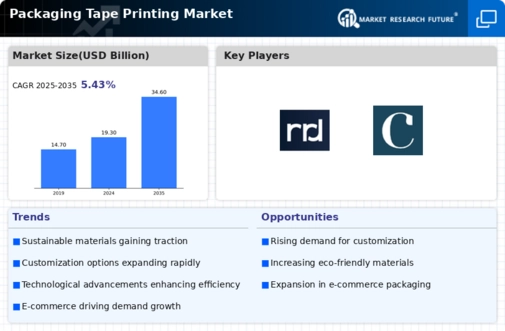Top Industry Leaders in the Packaging Tape Printing Market

The packaging tape printing market is a rapidly growing industry driven by the increasing demand for customized and branded packaging solutions. This growth is fueled by several factors, including the rise of e-commerce, the growing emphasis on sustainability, and the increasing demand for product personalization.
Strategies Adopted by Players in the Packaging Tape Printing Market
The key strategies adopted by players in the packaging tape printing market include:
-
Innovation: Players are investing in R&D to develop new and innovative printing technologies, such as digital printing and flexographic printing, which offer high-quality printing and faster turnaround times. -
Expansion of product portfolios: Players are expanding their product portfolios to offer a wider range of printing options, such as custom printing, security printing, and tamper-evident printing. -
Geographical expansion: Players are expanding their geographical reach by entering new markets and establishing partnerships with local distributors. -
Sustainability: Players are increasingly focusing on developing sustainable packaging tape printing solutions, such as using recycled materials and water-based inks. -
Focus on customer service: Players are focusing on providing excellent customer service to build strong relationships with their customers.
Factors for Market Share in the Packaging Tape Printing Market
The key factors that influence market share in the packaging tape printing market include:
-
Product quality and innovation: The ability to offer high-quality printing and innovative printing solutions is essential for gaining market share. -
Price competitiveness: Players need to offer competitive prices to attract customers. -
Customer service: Providing excellent customer service is essential for building strong relationships with customers and retaining their business. -
Distribution network: Having a strong distribution network is essential for reaching a wider customer base. -
Sustainability: Players who offer sustainable packaging tape printing solutions are increasingly gaining market share.
Key Players:
- Quad/Graphics Inc. (U S.)
- Hewlett-Packard Development Company LP. (U.S.)
- I. du Pont de Nemours and Company (U.S.)
- Xerox Corporation (U.S.)
- SIAT S.p.A (Italv).
- RR Donnelley & Sons (U S.)
- Canon U.S.A., Inc. (U.S.)
- FLEXcon Company, Inc. (U.S.)
- WS Packaging Group (U.S.) and Cenveo, Inc. (U S.)
Recent Developments :
In January 2022, Sole Source Capital LLC stated that IDL, a portfolio business of Sole Source Capital LLC, acquired three companies: Multi-Action Communication, Digital Printing Concepts, and Valley Forge Tape & Label business, expanding the company's portfolio in digital printing labels tape.
In October 2021, Fortis Solutions Group, a major provider of printed packaging solutions, bought Quality Tape Label with the intention of expanding its portfolio in the flexible packaging pressure-sensitive label industry.
In May 2019, The Printed Tape Association of Neenahh, WI has been acquired by Converting Unlimited Tape, LLC. The 56,000 square foot facility in Seymour will be acquired by the corporation, expanding its portfolio in the Packaging Tape Printing Market.
Blue Lake Packaging is excited to introduce an eco-sustainable alternative to traditional wrapping tapes as the holiday season approaches this December. Available now on Amazon, Blue Lake ECOLIFE Plastic-Free Tape and Dispenser combines wood with cotton fibers, which it is hoped will appeal to the growing number of customers who are looking for eco-friendly products. However, ECOLIFE Plastic-Free Tape and Dispenser are alternatives that have just as much sticking power and dispensing force besides being completely sustainable. Each set contains four rolls of tape around paper cores plus one reusable dispenser; these are packaged in plastic-free, non-bleached packages that can easily be recycled alongside other paper products. This helps address both waste generation concerns and lack of transparency in recyclable packaging – two-thirds of customers, according to McKinsey’s 2023 “Sustainability in Packaging” report.

